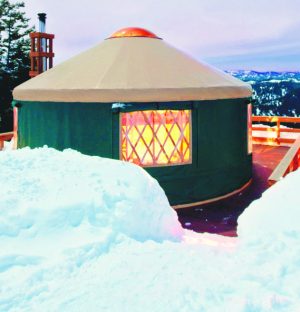Chart #1 on the top right shows a hydrocarbon molecule on the left and a fluorocarbon molecule on the right. The molecules can be combined forming a fluorinated hydrocarbon molecule which is shown at the bottom.
Additionally, the respective lengths of the hydrocarbon part and the fluorocarbon part can be varied which changes the properties of the resulting fluorinated hydrocarbon wax. Fluorinated hydrocarbons with longer fluorocarbon parts are more expensive and also more “potent” than those with shorter fluorocarbon parts. This is illustrated in Chart #2 on the left.The upper type shown has a long fluorocarbon chain on the left coupled with a shorter hydrocarbon chain on the right forming a fluorinated hydrocarbon molecule that would be more expensive and also more potent. The lower one has shorter fluorocarbon and longer hydrocarbon parts resulting in a less expensive and less potent fluorinated hydrocarbon molecule. What can you learn from this? When a wax company representative tries to fill your head with stories about what a “high percentage of fluorine” his brand contains, you can probably assume that they are using the cheap and less potent type of fluorinated hydrocarbon. How to cut through the rhetoric? I recommend skiing on the products that seem to perform well and not to base decisions on talk.
Here are some other noteworthy characteristics of fluorinated hydrocarbon waxes:
1. They are generally more resistant to dirt than hydrocarbons. Of course any soft wax contains more oil than a harder wax and would thus be worse against dirt, but given a similar hardness, the HF waxes are far more dirt resistant than hydrocarbon waxes.
2. They are also more durable than hydrocarbon waxes. Given the same hardness, an HF wax is more durable than a hydrocarbon wax.
3. They are more hydrophobic. Given the same hardness (soft waxes are generally more hydrophobic than hard waxes), an HF wax is better in wet conditions than a hydrocarbon wax.
4. Generally speaking, the harder fluorinated waxes such as HF Blue contain less fluorine in them than the softer ones such as HF Yellow. The harder waxes also contain synthetic additives which make them better in the cold which the softer waxes do not contain. Despite it containing fluorine, HF Blue is not close to as fast when the snow is wet as HF Yellow. HF Blue is specifically formulated to perform in the cold.
5. In the Toko line, given the proper “color” for the condition, the HF wax is generally faster than the hydrocarbon wax. One thing that people seem to overlook is that fluorine is not just good in wet conditions. Fluorinated hydrocarbon waxes are simply very slippery far so more than hydrocarbon waxes. Hold one of each in your hand (of similar hardness, let’s say Red) and rub your thumb over them. The HF wax feels more like soap (and slipperier) and the hydrocarbon wax feels more like wax. One factor in determining whether a wax is fast or not is simply “slipperiness”. The HF waxes are slipperier than the hydrocarbon waxes.
6. There is another reason that we use HF waxes constantly besides them being faster in general. HF waxes are the idea platform to put a fluorocarbon overlay on. Pure fluorocarbons (overlays such as HelX and JetStream) do not “like” hydrocarbons. They try to get “away” from them in any way that they can in a fashion similar to when two positive sides of a magnet come together or when oil and water are attempted to be mixed. However, the HF wax bonds well to a base (and to hydrocarbon waxes) and fluorocarbons bond far better to HF waxes. It is also worthwhile to note that when a ski is waxed with an HF wax, the molecules align them selves such that the hydrocarbon part angles down toward the ski and the fluorinated part angles up away from the ski. For this reason, when a fluorocarbon overlay is applied over an HF wax, it is almost entirely on the fluorocarbon part of the molecule. The picture to the left illustrates this. The squares represent the hydrocarbon part of the HF molecule and the small circles the fluorinated part of the HF molecule. The big circles represent the fluorocarbon overlay that is being applied. The ski base is represented by the entire big rectangle. Hopefully this chart helps illustrate this truth. The bottom line is that when a fluorocarbon is applied over an HF wax, the fluorocarbon wax job will last far longer than when it is applied over a hydrocarbon. Obviously when using an LF wax, the durability is somewhere between the two extremes.So, we use HF waxes because they are faster in general and also so our fluorocarbon overlay performs for us for a longer period of time.
Field Report from CXC at the SuperTour
With three races in less than 48 hours at the Michigan Tech SuperTour, having fast skis and good was important — we really wanted to avoid unnecessary energy expenditure. We tested Friday morning and afternoon, Saturday morning and afternoon, and Sunday morning to find the best skis possible for the CXC Team.
All three days, we based with an HF Blue/Moly mix and powdered with Jetstream Blue. Friday’s sprint was at 3pm, and the tracks were glazing a bit — there’d also been a little bit of freezing rain on Thursday afternoon that got groomed in. We ended up waxing a bit warmer than we’d assumed we would for kick — various combinations of Violet, Red and Yellow, depending on the skier’s needs.
For Saturday’s 5/10 classic race, we found the Red Bloc was running really well for glide, and Violet and Red with some Blue cover worked well for kick. A few inches of snow fell before the race on Sunday, and HelX Blue was ridiculously good. Ridiculous. We ended up with three wins (Maria Stuber 5km classic, Garrott Kuzzy 15km skate, Caitlin Compton 10km skate), seven top-threes and 13 top-sixes (SuperTour paying) for the weekend.
Thanks to the Michigan Tech organizing crew for the awesome races and facilities!
The Toko wax tip for the Boulder MT Tour held up well. Key was stiffer skis (glide well on icy snow and also stay cleaner than soft skis) with a fine structure. The LF Moly, HF Blue, JetStream Blue with Blue Structurite was great despite the warmer temperatures.
Toko WaxCoach now available as an iPhone app!
Click HERE to check it out.






![National camp action [P]...](https://skitrax.com/wp-content/uploads/2019/08/Duluth-4-2019-08-08-at-10.46.51-AM-300x246.png)
![Matt Liebsch on the CXC Elite Team [P] CXC...](https://skitrax.com/wp-content/uploads/2019/08/Matt-Liebsch-CXC.2-525x700.4-300x267.jpg)
![Dan LaBlanc [P]...](https://skitrax.com/wp-content/uploads/2019/08/Dan-LaBlanc-img_1855.3.jpg)

![Chart #1. [P] Toko US](http://skitrax.com/wp-content/uploads/2011/02/1-200x134.jpg)
![Chart #2 [P] Toko US](http://skitrax.com/wp-content/uploads/2011/02/21-200x133.jpg)
![Chart #3 [P] Toko US](http://skitrax.com/wp-content/uploads/2011/02/3-200x275.jpg)
![CXC Train at the front of the pack. [P] Toko US](http://skitrax.com/wp-content/uploads/2011/02/cxctrain.jpg)
![Caitlin Compton and Martina Stuber off the front. [P] Toko US](http://skitrax.com/wp-content/uploads/2011/02/compton_stuber.jpg)
![Evelyn Dong enroute to winning the Boulder MT Tour. [P] Toko US](http://skitrax.com/wp-content/uploads/2011/02/dong.jpg)